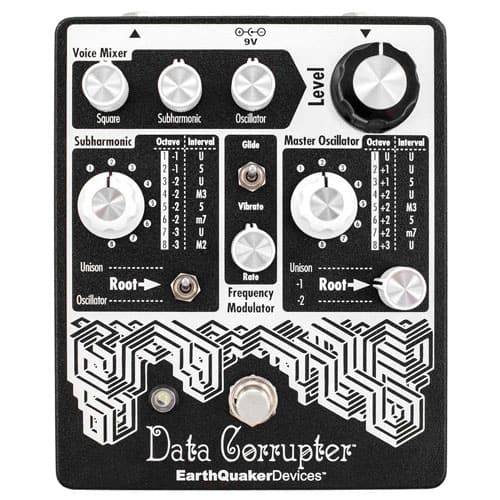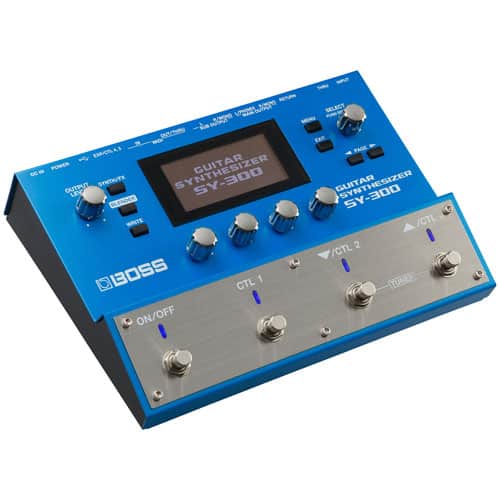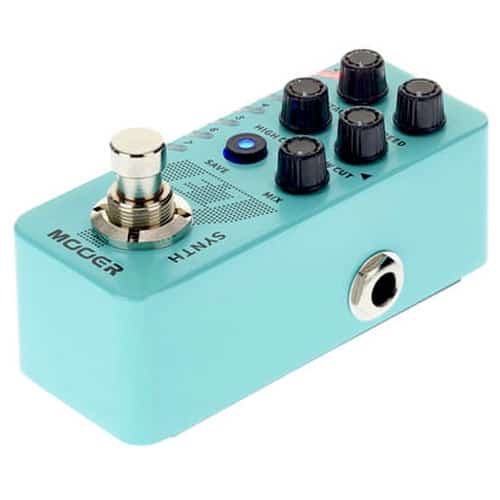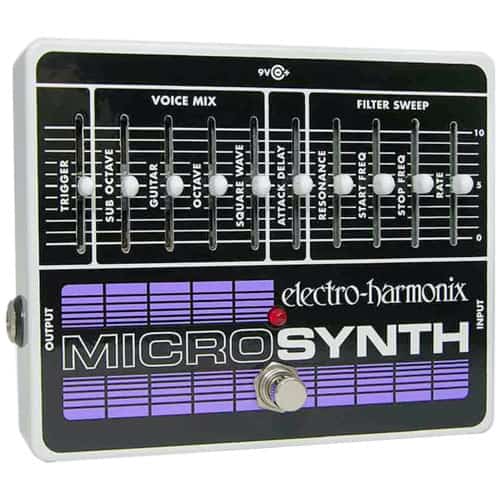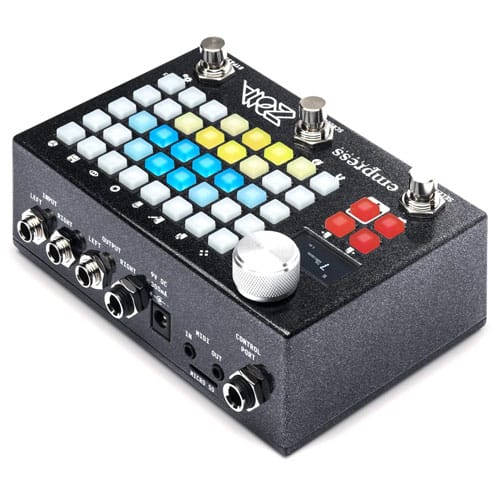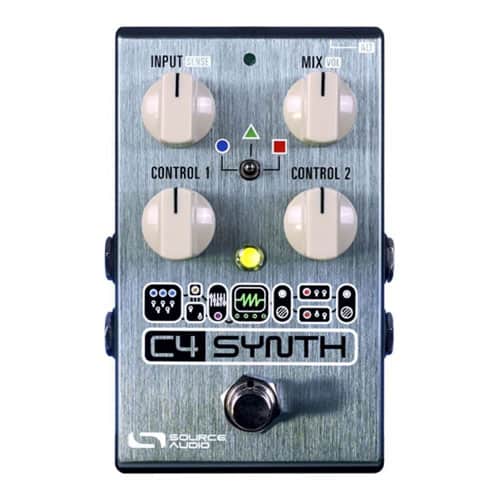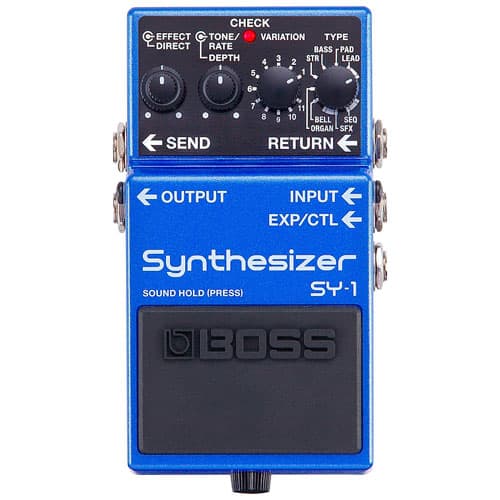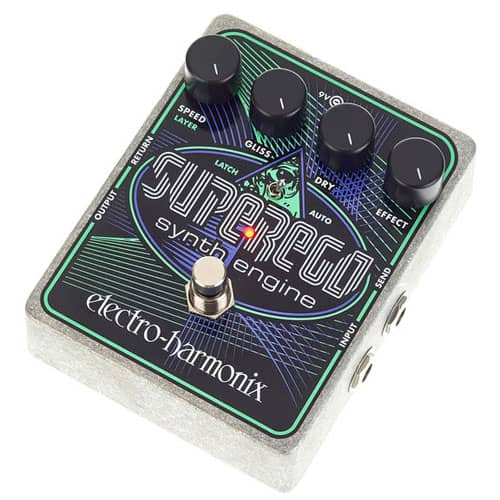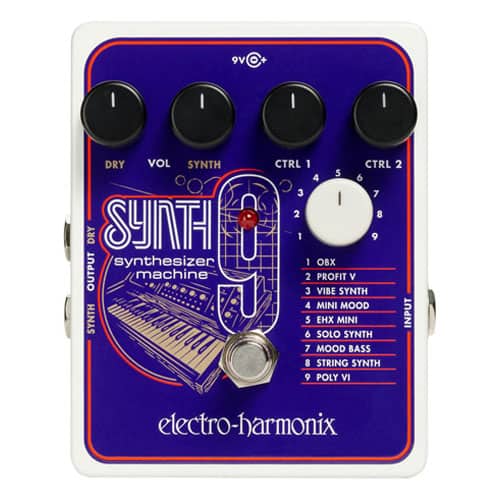Table of Contents
Are you the type of player who likes to change up the tone of your guitar? If you’re looking for a change, there’s no better way to experiment with new sounds than to load a synth onto your pedalboard.
The key is to choose the synth pedal that will best suit your needs — and that’s no easy feat in such a crowded selling space.
If you need some help deciding which pedals are worthwhile, we’ve got you covered.
After testing nine of the best synth pedals on the market, we’ve chosen the Earthquaker Devices Data Corrupter as the best all-around pedal for its unique take on sound.
Even if it’s not a good fit for your needs, one of the other eight pedals on our list is sure to be a great choice. So, read on to find the best guitar synth pedal for you.
The 9 Best Guitar Synth Pedals:
| Image | Synth Pedals | Summary | Check Price |
|---|---|---|---|
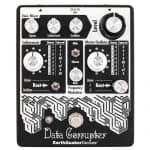 | Earthquaker Devices Data Corrupter | Best Choice: This monster of a pedal takes a completely different approach than most, so prepare to have your mind blown | Check price |
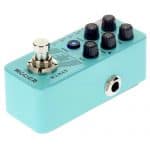 | MOOER E7 Polyphonic Guitar Synth Pedal | Best Value: A superb cost-effective model from Mooer, offering great synthesizer sounds on a budget | Check price |
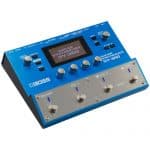 | Boss SY-300 Guitar Synthesizer Pedal | Premium Pick: The SY-300 offers a range of features that take it a step above most other pedals on the market | Check price |
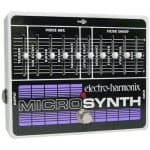 | Electro-Harmonix MicroSynth XO | Best Vintage Analog Synth: The solid choice for a pedal that mimics classic synthesizer tones from the past | Check price |
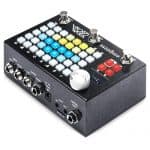 | Empress Effects ZOIA | Best Modular Synth: The unique design offers a level of flexibility not found in even some of the best guitar synth pedals | Check price |
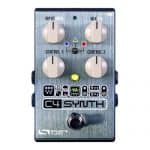 | Source Audio C4 Synth Pedal | Top Compact Synth Pedal: The level of flexibility in this small package is nothing short of impressive | Check price |
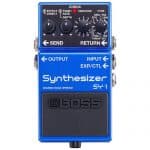 | Boss SY-1 Synthesizer Effects Pedal | Most Rugged Synth Pedal: It’s a Boss pedal. Is there really anything more that needs to be said? | Check price |
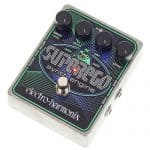 | Electro Harmonix Superego Synth Pedal | Most Unique Synth Engine: A new approach to guitar synth pedals that produces fresh, new tones | Check price |
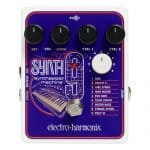 | Electro-Harmonix SYNTH9 Pedal | Best ’80s Synth: An effective way to mirror the popular sounds from the decade when synthesizers ruled the scene | Check price |
Earthquaker Devices Data Corrupter
If you think a synth’s only job is to make your guitar sound like a keyboard, spending a few minutes with this bad boy will change your view forever.
That’s because the Earthquaker Devices Data Corrupter has so much to offer.
Where the magic lies is the three stages of signal manipulations that form the core of how this innovative pedal works. First is a simple fuzz tone. Next is a ‘Subharmonic’ stage where that signal can be altered to one of eight intervals, including an oscillating mode for more mayhem.
An additional oscillating mode allows for even more interval and octave changes. Put it all together and you have the potential for tonal onslaught that may be like nothing you’ve ever experienced before.
With its all-analog circuitry housed in a rugged yet attractive housing, this pedal is the perfect balance of form and function.
Positives
- Three-stage signal manipulation for crazy and unpredictable sounds
- Attractive and durable ‘boutique’ style package design
Negatives
- While it’s a great effect, it’s not ‘mainstream’ and it may not be to everyone’s taste

MOOER E7 Polyphonic Guitar Synth Pedal
The MOOER E7 Polyphonic Guitar Synthesizer Pedal is proof positive that you don’t have to have an expensive pedal to get high quality tones.
Starting things off with the E7 is seven different preset tones. While you can’t do any deep editing of the overall waveforms, a number of adjustments can be made courtesy of the five knobs on top of the durable housing.
Attack and speed (along with hi and low cuts) can be easily tweaked and the wet signal can be mixed with the dry (unprocessed) signal to let you control the overall mix. You can also save all of your changes.
Another benefit of the E7 is its size. It has the ‘micro’ or ‘half pedal’ sized form factor, making it a great choice to get some inspiring sounds while taking up only a little of the precious room on your pedalboard.
Is it a full-blown guitar synthesizer replacement? Of course not. But the MOOER E7 is one relatively inexpensive way to add synth power to your sonic toolbox.
Positives
- Seven preloaded synth-type sounds with a wide range of adjustments
- Micro-sized package makes it perfect for crowded pedalboards
Negatives
- Applications are somewhat limited, but not a bad way to go on a budget

Boss SY-300 Guitar Synthesizer Pedal
When guitar synth units were introduced, many of them were unwieldy, complicated units that required a special pickup be installed into your guitar. With the Boss SY-300, you can get a good representation of a full guitar synth without all of the extra baggage — and with no special hardware.
Much more than a simple pedal, the SY-300 has a very impressive feature list. The variety of tones you can create is almost endless.
You’ll find a number of low frequency oscillators (LFOs), filters, amplifiers and a bunch of other goodies to create sounds that you just can’t get from similar models.
The controls setup allows for ease of use, with four foot switches and a LCD screen to make program changes a piece of cake. There are also 99 user-preset slots available to save your tonal creations, along with 70 stock slots to get your juices flowing from the start.
Yes, it’s a little pricey but, with everything it has to offer, the Boss SY-300 is one pedal that’s definitely worth the price of admission.
Positives
- Expansive feature set to develop a wide range of tones
- Several foot switches and a LCD screen enable ease of use
Negatives
- With its wide range of settings, it may take some time to tap into its full potential

Electro-Harmonix MicroSynth XO
Synthesizer pedals can be very useful tools for players that need to replicate a particular tone in a live setting (such as in a cover band that may not have a keyboard player).
In these cases, the Electro-Harmonix MicroSynth XO is a very attractive solution.
The MicroSynth XO has a wide range of slider switches to let you craft those old school analog synth tones. The dry guitar signal can be mixed with both an octact up/down, along with a square wave.
From there, several controls over the internal filter let you craft your sound and there is even an attack setting that lets you control fade-in of notes.
The all analog, true bypass circuit is housed in a die cast aluminum housing that is more than rugged enough for extended live use. Overall, the MicroSynth XO is one of the better tools for adding some vintage synth tones to your arsenal.
Positives
- Multi-voice settings can be individually mixed, then adjusted with several filter controls
- Attack setting allows for control of fade in, giving a smoother sound
Negatives
- There is no way to save different synth setups as presets

Empress Effects ZOIA
Guitar synthesizer pedals can be fun, but they are just foot pedals — there is only so much they can do. The Empress Effects ZOIA throws that idea straight out the window with an innovative modular design that’s both fun and functional.
The way the ZOIA is designed, there are more than 80 modules that can be loaded into the pedal. You’ll find everything from LFOs and filters to envelope followers. There are even 20 effects modules available as well as delays and overdrives.
Up to 64 different patches can be saved, so you can let your creativity flow without worrying about remembering the settings for that awesome sound you just created.
The ZOIA is one extremely flexible pedal, but comes with a price bump. Based on what you get, though, it’s hard to argue that it isn’t worth it.
Positives
- Modular design with 80-plus synth functions and more than 20 effects
- Creative visual design with an OLED display for easy patch creation
Negatives
- Pricing is higher than most synthesizer pedals on the market

Source Audio C4 Synth Pedal
The space on your pedal board is something to be treasured. If you don’t have a lot of room to spare, the C4 guitar synthesizer from Source Audio is a great way to pack a lot of punch without taking up a lot of real estate.
At first glance, the C4 looks pretty simple with its four knobs and a single mini toggle. Don’t let that fool you though, because there’s plenty under the hood.
While the controls themselves are somewhat limited, the power here exists within the Neuro Desktop Editor (or mobile app) that has a mind-blowing level of tone sculpting options.
What you can do with the C4 is far beyond the scope of some other synthesizer pedals on the market, despite its micro form factor. Harmonization, sequencing and distortion effects are only a portion of what is offered beyond the ‘typical’ synth sounds.
Small size, big power — that’s the Source Audio C4.
Positives
- Power and flexibility with the Neuro Desktop Editor and Mobile App
- Small package size is a great fit for crowded pedal boards
Negatives
- May be hard to tweak within in a live performance setting

Boss SY-1 Synthesizer Effects Pedal
No roundup review of any type of guitar pedal would be complete without the presence of some Boss models. While the SY-300 we looked at earlier is impressive, The SY-1 Synthesizer is yet another Boss unit that provides a high level of flexibility, functionality, great tone and value.
The best guitar synth pedals can be confusing to set up and use. Not the SY-1. It takes all of the guesswork out, with 121 preset sounds that require absolutely no programming at all.
Sounds range from organs, strings and bells and that’s in addition to tones specifically meant for single note solos or full chords.
Countless players have used Boss pedals over the years, and a big reason for that is their legendary durability. They are designed to be tough, and built to stand up to the rigors of the road.
The SY1 Synthesizer offers legendary Boss sound and build quality all in one simple pedal package.
Positives
- 121 preset tones across a range of different categories
- No programming needed, making it perfect for those that don’t care to be technical
Negatives
- Some of the sounds meant to mimic other instruments could be more realistic

Electro-Harmonix Superego Synth Pedal
Not all synth pedals are meant to be vintage synth substitutes or ways to copy the sounds of other instruments. Some are just meant to be different — and cool. That’s what the EHX Superego is all about.
The Superego is an innovative model in that it offers a unique way of blending tone samples, long sustains and the ability to ‘freeze’ tones. It has the ability to ‘gliss’ between sounds to create something totally unexpected and out of the ordinary.
Controls are relatively simple, with no need for any offline programming. Adding to the flexibility is an effects loop that lets you mix in your favorite effects for almost unlimited possibilities.
The EHX Superego has to be heard to be appreciated. Do yourself a favor and check it out. You may be pleasantly surprised at what you can come up with.
Positives
- New and unique approach to creating synth tones that are out of the box
- Simple control layout requires no programming
Negatives
- Not meant for those looking to replicate vintage synth sounds

Electro-Harmonix SYNTH9 Pedal
The ’80s was a time when the synthesizer pretty much dominated the music world. Even traditional guitar heroes like Eddie Van Halen made a huge stamp on the decade.
The SYNTH9 from EHX offers a great sounding and effective way to get many of those sounds from your guitar, all in a compact pedal-sized package.
Featuring nine specific presets that were made to evoke that ’80s vibe, the SYNTH9 is incredibly easy to use. Simply select from the range of sounds using a single rotary knob, then tweak to taste with two control knobs that change different parameters (depending on the tone).
The ability to mix the wet signal with the dry is super easy too, so your sounds can be as intense or subtle as you want them to be. On top of that, there are separate one-quarter inch outputs for each signal, allowing for additional offline processing.
If ’80s music is your jam, then the EHX SYNTH9 may be the guitar synth for you.
Positives
- Nine preloaded tones that mimic some of the most popular synth sounds associated with the ’80s
- Incredibly easy to use with a minimum of adjustments needed to produce rich sounds
Negatives
- No method exists to save individual tones. You would have to document knob settings to recreate the same sounds

What does a guitar synthesizer do?
A guitar synthesizer takes a standard guitar signal and manipulates it in ways that nature never intended. Through the use of items like LFOs, filters and wave generators, they can be used to create completely new sonic experiences or to try to copy other instruments.
With guitar synth pedals, many of these functions are packaged into one convenient unit that easily fits on most pedalboards. They typically aren’t ‘full function’, so you may want to experiment with a few different models to see which ones will produce the kinds of sounds needed/wanted/desired.
If you’re looking to mimic the tones of other instruments, you may need to keep your expectations in check about what a synth pedal can provide. Analog waveforms are extremely complex animals. Getting your guitar to sound exactly like a horn section, for example, may not be completely doable.
What features should a good guitar synth pedal have?
One big feature any good model should have is a way to control the mix of dry (guitar) and wet (after effects are applied) signals. Some synth tones may be a bit too aggressive to use on their own. Having the ability to add in some dry signal to mellow things out may be the answer.
What makes a ‘good’ feature also depends largely on whom the player is and what he or she wants to do. Some may want a unit like the Boss SY-1 Synthesizer where everything is pretty much pre-set with minimal tweakability, while others may gravitate toward the Source Audio C4 that has an offline editor for a high level of deep editing.
One of the best ways to decide is simply by spending time with a few models to determine which approach works. Some retailers have generous return policies, so there’s nothing wrong with exploring your options and making the right choice for your needs.
Where does a synth pedal go in your pedalboard chain?
Using the majority of synth pedals as a guideline, it’s best to place your pedal as early in the chain as possible i.e. nearer to your preamp pedal. Synths work off a process called ‘tracking’, which means the pedal has the ability to grab on and recognize a note (or range of notes, if you are using a polyphonic unit).
Having a nice and clean signal for the circuitry to work with will greatly improve its tracking ability. That, in turn, will increase reliability and give you better overall sound.
If you place the pedal too far up the chain — for example, after several other types of effects, phaser pedals, etc — the signal may be a bit more cluttered and won’t track nearly as well. This is especially true if you place it after distortion or fuzz pedals.
But to each their own. There’s nothing wrong with doing some experimentation and seeing what works and what doesn’t. Some players may like the unpredictability that a strange signal chain placement can provide.
What other synth pedals are worth considering?
While the nine pedals we looked at are the cream of the crop, there certainly are plenty of honorable mentions worth taking a look at:
- Red Witch Synthotron II – A very flexible synthesizer with multiple oscillators, each with an extensive controls set to make your sound your own.
- DigiTech Dirty Robot Stereo Mini-Synth Pedal – The DigiTech Dirty Robot lets you morph and mix several octave and waveform settings, with a secret switch to add ‘cybernetic’ tones and textures.
- Meris Enzo Synthesizer – A great pedal solution with exceptional tracking capabilities, even for polyphonic uses such as full chords.
- Seymour Duncan FOOZ Analog Fuzz Synth – The FOOZ gets LFO, fuzz and filter blocks working together to produce a broad selection of synth and effect-laden tones.
- Earthquaker Devices Rainbow Machine V2 – Not a typical guitar synth pedal, the Rainbow Machine uses DSP pitch warping to find that ever elusive tone pot o’ gold.
- Keeley Synth-1 Wave Generator – Gives you a ton of single note synth options for far out sonic experiments (chords need not apply).
Bottom Line
Guitar synth pedals certainly aren’t for everyone. At the same time, they can be one of the best tools to help get some new and inspiring tones out of your rig.
Models like the Earthquaker Devices Data Corrupter (our top pick) check a lot of the boxes, but you can’t deny what some of the worthy runner ups (such as the Empress Effects ZOIA or the Boss SY-1 Synthesizer Effects Pedal) bring to the table.
Take some time to check them out and find the guitar synth pedal that’s right for you. There’s certainly nothing wrong with getting a little funky, and making your old boring analog guitar a little more interesting.
Do you have a synth pedal on your board? What pedal have you had the most luck with? Let us know in the comments below.
